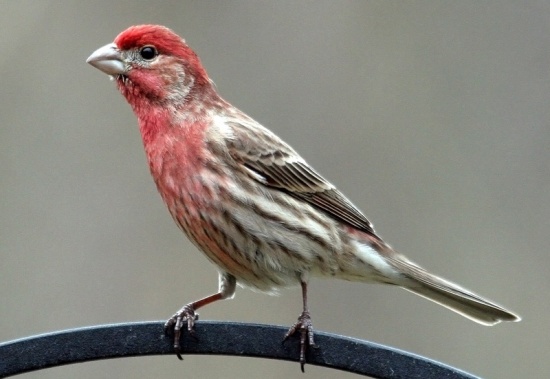BigRedBirder (talk | contribs) |
|||
| Line 1: | Line 1: | ||
| + | [[catgory:incomplete]] | ||
;Carpodacus mexicanus | ;Carpodacus mexicanus | ||
| − | [[Image:House_Finch.jpg|thumb|550px|right|Photo by skiel | + | [[Image:House_Finch.jpg|thumb|550px|right|Photo by skiel <br/>Photographed: Orange County, New York, USA. |
| − | Photographed: Orange County, New York, USA. | + | ]] |
==Identification== | ==Identification== | ||
| − | 5-6" (13-15 cm). | + | 5-6" (13-15 cm). Bright red on crown, breast, and rump. Female has plain, unstriped head and heavy streaking on light underside. Immature males less highly coloured, often orangish or yellowish on head and breast. |
==Distribution== | ==Distribution== | ||
| − | + | [[North America]], [[Canada]] to southern [[Mexico]] | |
| + | |||
==Taxonomy== | ==Taxonomy== | ||
==Habitat== | ==Habitat== | ||
| − | + | Deserts, orchards, coastal valleys and forests. | |
| − | + | ==Behaviour== | |
| − | == | + | A tightly woven, compact nest is made and set in a bush, thicket, natural cavity, or on a building. 3-5 bluish, lightly streaked or spotted eggs are laid. |
| − | |||
| − | |||
| − | + | Diet includes insects and grass seeds. | |
| − | |||
==External Links== | ==External Links== | ||
*[http://www.birdforum.net/pp_gallery/showgallery.php?mcats=all&what=allfields&si=Carpodacus+mexicanus View more images of House Finch in the gallery] | *[http://www.birdforum.net/pp_gallery/showgallery.php?mcats=all&what=allfields&si=Carpodacus+mexicanus View more images of House Finch in the gallery] | ||
[[Category:Birds]] | [[Category:Birds]] | ||
Revision as of 13:27, 3 October 2007
- Carpodacus mexicanus
Identification
5-6" (13-15 cm). Bright red on crown, breast, and rump. Female has plain, unstriped head and heavy streaking on light underside. Immature males less highly coloured, often orangish or yellowish on head and breast.
Distribution
North America, Canada to southern Mexico
Taxonomy
Habitat
Deserts, orchards, coastal valleys and forests.
Behaviour
A tightly woven, compact nest is made and set in a bush, thicket, natural cavity, or on a building. 3-5 bluish, lightly streaked or spotted eggs are laid.
Diet includes insects and grass seeds.




